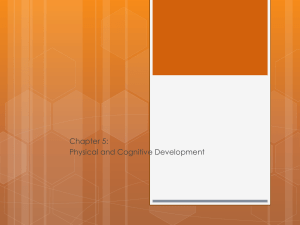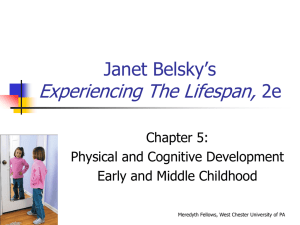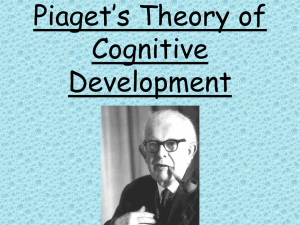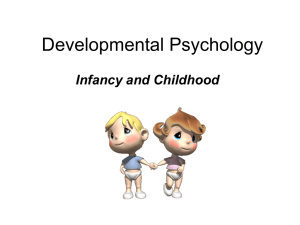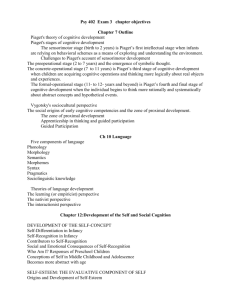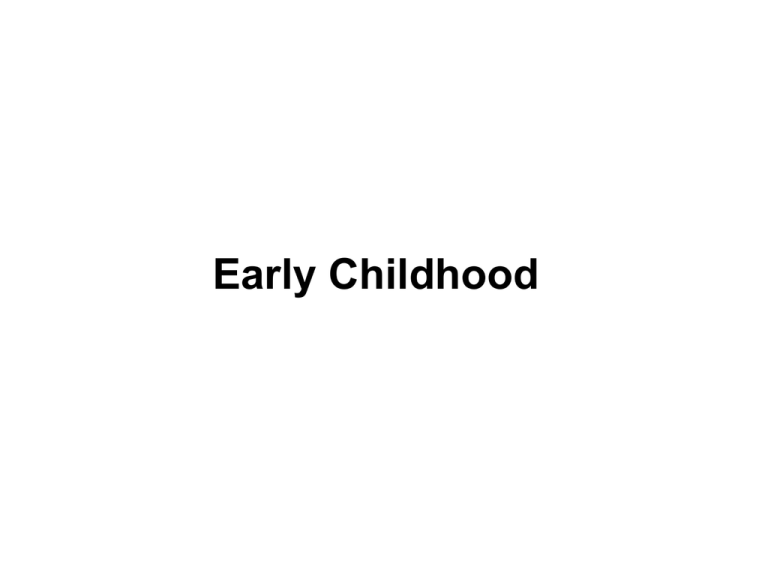
Early Childhood
Physical Development: Key Highlights
Bodily Growth and Change
Sleep Patterns and Problems
Sleep terror: The abrupt awakening of a child or adult from
deep sleep in a state of panic, usually about one hour after
falling asleep. The person typically remembers nothing
about the episode in the morning. Also known as a night
terror.
Enuresis: Repeated urination in clothing or in bed.
Physical Development: Key Highlights
Motor Skills
Gross motor skills: Physical skills that involve the large
muscles.
Fine motor skills: Physical skills that involve the small
muscles and eye-hand coordination.
Systems of action: Increasingly complex combinations
of skills, which permit a wider or more precise range of
movement and more control of the environment.
Handedness: Preference for using a particular hand.
Cognitive Development
I. PIAGET: THE PREOPERATIONAL CHILD
Preoperational stage: In Piaget’s theory, the second major
stage of cognitive development in which children become
more sophisticated in their use of symbolic thought but are
not yet able to use logic.
Advances of Preoperational Thought
The Symbolic Function
Symbolic function: Piaget’s term for ability to use mental
representations (words, numbers, or images) to which a child has
attached meaning.
Deferred imitation: Imitation of an action at a later time, based on a
mental representation of the observed action.
Pretend Play: Play involving imaginary people and situations.
Understanding of Objects in Space
Understanding of Causality
Transduction: In Piaget’s terminology, a preoperational child’s
tendency to mentally link particular experiences, whether or not there
is logically a causal relationship.
Familiar settings helps advance causality.
Understanding of Identities and Categorization
Identities: The concept that people and many things are basically the
same even if they change in form, size, or appearance.
Animism: Tendency to attribute life to objects that are not alive.
“The cloud is smiling at me!”
Familiarity increases accuracy.
“I know that a person is alive and that the kitchen table is not
alive.”
Immature Aspects of Preoperational Thought
Egocentrism: Piaget’s term for the inability to consider another
person’s point of view.
Three-mountain task: A child sits facing a table that holds three large
mounds, with a doll in the opposite chair. The child is asked how
the “mountains” would look to the doll.
Conservation: Piaget’s term for the awareness that two objects
that are equal according to a certain measure remain equal in
the face of perceptual alteration so long as nothing has
been added to or taken away from either object.
Irreversibility: Piaget’s term for a preoperational child’s
failure to understand that an operation can go in two or
more directions.
Focus on successive states: In Piaget’s theory, the
tendency for preoperational children to focus on the end
states rather than the transformations from one state to another.
Do Young Children Have Theories of Mind?
Theory of mind: Awareness and understanding of
mental processes.
Knowledge about Thinking and Mental States
False Beliefs and Deception
What do you think is in the Crayon box?
Crayons!
What is actually in the Crayon box?
Candy!
What do you think Joe will say is in the Crayon box?
Candy!
Distinguishing Between Appearance and Reality
Distinguishing Between Fantasy and Reality
In What Order Do Theory-of-Mind Abilities Develop?
Influences on Individual Differences in Theory of Mind
Development
II. INFORMATION PROCESSING APPROACH:
MEMORY DEVELOPMENT
Basic Processes and Capacities
Encoding: Process by which information is prepared for long-term
storage and later retrieval.
Storage: Retention of memories for future use.
Retrieval: Process by which information is accessed or recalled from
memory storage.
Sensory Store: the very brief storage of sensory information
and is the first stage of memory processing.
Short-Term (Working) Memory: the temporary storage of
recent events.
3 main components:
Phonological loop: which stores and rehearses speech information.
Visuospatial sketchpad: stores and manipulates visual and spatial
information.
Central Executive: governs shifts of attention.
Long-term memory: a relatively permanent storage of mostly
meaningful information.
Recognition: Ability to identify a previously encountered
stimulus.
Recall: Ability to reproduce material from memory.
Forming Childhood Memories
Generic: Produces ‘scripts’ –general outlines of repeated
and familiar events.
Episodic: Remembering a specific event at a specific time.
Autobiographical: Memories that form a person’s life history;
tend to be specific and long-lasting.
Social Interaction, Culture, and Memory
Social interaction model: A model, based on Vygotsky's
sociocultural theory, which proposes that children construct
autobiographical memories through conversation with adults
about shared events.
Children as Eyewitnesses
Effective strategies in interviewing young children…
Use of simple questions.
Maintenance of a non-threatening atmosphere during the interview.
Avoidance of suggestions or pressure.
Schedule the interview as soon as is reasonable after the event.
III. INTELLIGENCE
Intelligence: a combination of general abilities and
practiced skill.
Intelligence quotient (IQ) tests: attempt to measure an
individual’s probable performance in school and similar settings.
Stanford-Binet IQ test
The average IQ score for all age groups is designated as 100.
Items are ordered by difficulty and classified by age level.
Wechsler Intelligence Scale for Children (WISC-IV)
The Verbal Comprehension Index
The Perceptual Reasoning Index
The Working Memory Index
Processing Speed
IV. LANGUAGE DEVELOPMENT
Vocabulary
Fast mapping: Process by which a child absorbs the meaning
of a new word after hearing it once or twice in conversation.
Grammar and Syntax
Children start using plurals, possessives, and past tense.
Know the difference between I, you, and we.
Most sentences are declarative.
I want this. I did this.
Errors with irregular verbs.
Holded instead of held
Psychosocial Development
I. THE DEVELOPING SELF
The Self-Concept and Cognitive Development
Changes in Self-Definition: The 5 to 7 Shift
Self-definition: Cluster of characteristics used to describe
oneself.
1. Single representations: First stage in development of
self-definition, in which children describe themselves in
terms of individual, unconnected characteristics and in
all-or-nothing terms.
“I can climb trees and I can count to 100.”
“I have a mother and a father and a sister and I like chocolate cake.”
“You can’t be happy and scared.”
Children can’t differentiate between their…
Real self (self-concept): Knowledge of who you really are.
And their…
Ideal self: Knowledge of who you would like to be or think
you should be.
2. Representational mappings: Second stage in
development of self-definition, in which a child makes
logical connections between aspects of the self but still
sees these characteristics in all-or-nothing terms.
“I can throw far, run fast, and jump high. I’m going to
be on a basketball team someday.”
3. Representational systems: Third stage in development
of self-definition, in which a child begins to integrate specific
features of the self into a general, multidimensional concept
and to articulate a sense of self-worth.
“I’m good at math, but not very good at reading.”
Self-esteem: The judgment a person makes about his or
her self-worth.
Cultural Differences in Self-Definition
Parents transmit cultural ideas and beliefs about how
to define the self.
Chinese parents encourage:
Compliance with authority
Sense of community
European-American parents encourage:
Individuality and self-expression
Self-esteem
Understanding and Regulating Emotions
Emotions Directed Toward the Self
Ability to recognize…
Guilt, Shame, Pride
Begins to develop around age 3 through a gradual
progression to age 8.
Erikson: Initiative Versus Guilt
Initiative versus Guilt: Erikson’s third crisis in psychosocial
development, in which children balance the urge to pursue
goals with moral reservations that may prevent carrying
them out.
Virtue attained…
Purpose: In Erikson’s third crisis, the courage to envision and pursue
Goals without being excessively inhibited by guilt or fear of punishment.
II. GENDER
Gender identity: Awareness, developed in early childhood,
that one is male or female.
Often developed through…
Identification: the process in which children attempt to be similar to
their same-sex parent, incorporating the parent’s attitudes and values.
Gender stereotypes: Preconceived generalizations about
male or female role behavior.
Gender differences: Psychological or behavioral differences
between males and females.
Different from…
Sex differences: physical differences between males and females.
Perspectives on Gender Development
Biological Approach
There are similar gender roles in many cultures.
Genetic, hormonal, and neurological evidence.
Gender reassignment often fails.
Cognitive Approach
Children classify themselves as male or female.
Adopt behaviors they perceive as consistent with their
gender.
Develop Schemas of what it means to be male or female.
Socialization-Based Approach
Family, Peer, and Cultural Influences
III. PLAY: THE BUSINESS OF EARLY
CHILDHOOD
Cognitive Levels of Play
Functional play: the lowest cognitive level of play, involving
repetitive muscular movements.
Constructive play: the second cognitive level of play,
involving use of objects or materials to make something.
Pretend play: the third cognitive level of play, involving
imaginary people or situations.
Formal games with rules: the fourth cognitive level of play,
involving organized games with known procedures and
penalties, such as hopscotch and tag.
The Social Dimension of Play
Parallel play: action in which children play with similar toys,
in a similar manner, but do not interact with each other.
Onlooker play: action in which children simply watch others
at play, but do not actually participate themselves.
Associative play: play in which two or more children actually
interact with one another by sharing or borrowing toys or
materials, although they do not do the same thing.
Cooperative play: play in which children genuinely interact
with one another, taking turns, playing games or devising
contests.
How Gender and Culture Influence Play
IV. PARENTING AND CHILD BEHAVIOR
Forms of Discipline
Power assertion: Disciplinary strategy designed to discourage
undesirable behavior through physical or verbal enforcement
of parental control.
Inductive techniques: Disciplinary techniques designed to
induce desirable behavior by appealing to a child’s sense of
reason and fairness.
Withdrawal of love: Disciplinary strategy that may involve
ignoring, isolating, or showing dislike for a child.
Psychological aggression: Verbal attacks on a child by a
parent that may result in psychological harm.
Parenting Styles
Authoritarian: relentlessly imposing rules and demanding
obedience.
Permissive: parenting style emphasizing self-expression and
self-regulation.
Uninvolved: do whatever you want.
Authoritative: have rules and control, but explain why it is
necessary in a loving and caring way.
Prosocial Behavior vs. Altruism
Prosocial behavior: Any voluntary behavior intended to help others.
Altruism: Any voluntary behavior intended to help others out of inner
concern and without the expectation of an external reward.
Aggression
Instrumental aggression: Aggressive behavior used as a
means of achieving a goal.
Hostile aggression: Action intended to hurt another person.
Overt aggression: Aggression that is openly directed at its
target.
Relational aggression: Aggression aimed at damaging or
interfering with another person’s relationships, reputation, or
psychological well-being.
Sources of Aggression: Nature and Nurture
Fearfulness
Systematic desensitization: Therapeutic technique involving
gradual exposure to a feared object or situation.

